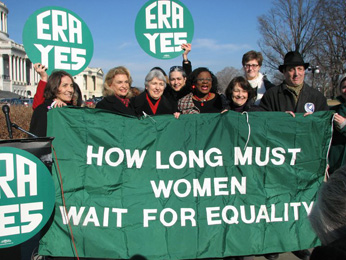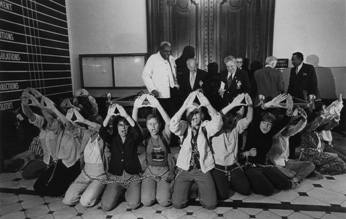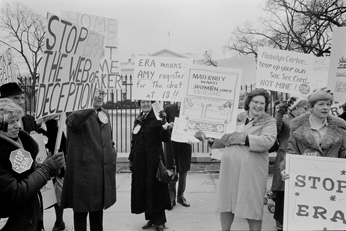Nov. 16, 2011 — “Equality of rights shall not be denied or abridged by the United States or by any state on account of sex.” That’s section one of the Equal Rights Amendment.
“The Congress shall have the power to enforce, by appropriate legislation, the provisions of this article.” That’s section two.
143 years after the ratification of the 14th Amendment (which had as its primary object preventing newly-freed slaves from being deprived of equal protection, due process, and the privileges and immunities of United States citizenship), and 81 years after women’s right to vote was secured by ratification of the 19th Amendment, ERA is still not on the books, and it is difficult to find very many people today who are optimistic about the short-term prospects for ratification. Those who do continue to fight for ratification say that they continuously come up against critique that the ERA is either dead or no longer relevant.
But talking to women’s rights advocates who were already active and engaged in the 1970s and 1980s tells a different story about the sense of what was — and still may be — possible and necessary. Indeed, back then it was the ratification of ERA — not its demise — that seemed nearly inevitable.
A Time of Overwhelming Support for ERA
The Constitution only permits Congress to propose amendments to the states when two-thirds of both the House and Senate agree to do so. That means a minimum of 290 votes in the House and 67 votes in the Senate if all members were voting.
In 1972, the ERA had widespread public and organizational support, and both House and Senate approved it with by overwhelming margins: 354 members of the House and 84 members of the Senate voted for it. Then-President Richard Nixon endorsed the proposed amendment.
Zoe Nicholson, longtime women’s and LGBT rights activist, currently founder of ERA Once and For All, explains that there was a sense that the amendment could not fail to be ratified. “There was an expectation in 1972 that the 38 states were going to fall like dominoes; that this was a no brainer.”
Why they fought
Many advocates, like Roberta Francis, director of the NOW ERA Task Force and active member of the League of Women Voters during the time that the ERA was before the states, were inspired by the gains made in the Civil Rights movement. They shared the view that the ERA would right a fundamental wrong and continue the tide of progress.
Sandy Oestreich, long-time ERA advocate and founder and president of the Florida Equal Rights Alliance, a group currently working for ERA ratification, says that despite having two jobs, she threw herself into ERA activism in 1972 because of this basic sense of injustice. “This wasn’t the America that I had been told about,” she remembers, “[the Constitution] is important. This is the cornerstone of America. The bottom line is that there is nothing as potent to protect against sex discrimination than the United States Constitution.”
Others, such as Eleanor Smeal — president of the National Organization for Women (NOW) from 1977 to 1982 and from 1985 to 1987 and current president and founder of the Feminist Majority Foundation — fought for more concrete reasons. “Why did I go after the ERA so hard?” Smeal reflected in the course of a conversation with Remapping Debate. “Because I saw how many cases we’ve lost and how hard it is to win.”
“I was very active in NOW and we were doing a lot of employment cases and education cases at the time and realizing that the laws were weak and that we were losing too many and that there [were] too many loopholes,” Smeal said.
Mary Francis Berry was assistant secretary for education in the U.S. Department of Health, Education, and Welfare from 1977 to 1980 and was a member of the United States Civil Rights Commission from 1980 to 1993 and thereafter its chair until 2004. She is the author of Why ERA Failed, and is currently a professor of history and American social thought at the University of Pennsylvania. She recalls, “When I was head of the Civil Rights Commission, we used to do studies on the ERA. I supported the people at NOW… because, at the time, I thought that equal rights for women, based on my own experience in the workplace, were something that was very much needed to open up opportunity. I also thought that women themselves would see that they need a constitutional basis for equality.”
Counter-revolution and response
The optimism among ERA supporters, a sense that ERA could not fail, seemed well placed in the beginning: 22 states ratified in the first year. “It was like bowling, they fell so easily,” Nicholson recalls. But the pace of ratification slowed, and, when Indiana ratified in 1977 — the last state to do so — ERA supporters could count only 35 states in the ratification column. That was three shy of the requisite 38 states needed to achieve the constitutionally mandated approval from three-quarters of the states.
During those five years, opponents of equal rights for women had been waging a fierce campaign to derail ratification. In the face of that campaign, ERA proponents lost the offensive, instead spending significant time denying that ratification would have an impact, for example, on reproductive freedom rights or the rights of gays and lesbians.
Beyond the fact that opponents had the advantage of needing only to prevent 13 states, most of which were solidly anti-ERA, from ratifying, they had another advantage: the ERA, like many modern amendments to the Constitution, was proposed to the states with a seven-year ratification deadline.
As the 1979 deadline neared and ERA supporters saw that they were not going to secure ratification in the three additional states needed, supporters pushed for a three-year extension. In Jul. 1978, a pro-extension rally in Washington attracted 100,000 ERA supporters.
“What [young] people like yourself don’t understand,” Sandy Oestreich told Remapping Debate, was that “the United States was on fire for the ERA.”
“Just picture every major newspaper emblazoned with ERA news everyday,” Oestreich added.
In Oct. 1978, Congress — by simple majority vote of 233-189, not the two-thirds margin needed for approving an amendment in the first place — extended the deadline for ratification to 1982.
ERA advocates focused their hopes for ratification on three states: Illinois, Virginia, and Florida. As the 1982 deadline approached, recalls Nicholson, activists marched on the streets of Chicago, picketed the White House (President Ronald Reagan opposed the ERA), and chained themselves to the doors of the Illinois State Senate. Nicholson herself was one of seven women in Illinois who went on hunger strike to show their support for ratification. Nicholson said she remained optimistic during that time.
“Every moment, we believed it was going to change the tide,” she says. “You cannot go without food, you cannot live on water for 37 days without believing that what you’re going to do will be successful.”
The hunger strikers stopped fasting after 37 days when the ERA failed by four votes to achieve in the Illinois state senate the 60 percent supermajority required by the state’s constitution.
Ratification efforts also fell short by a handful of votes in both Florida and Illinois, and ERA had been defeated.
“Once the ERA failed to pass, a lot of people lost interest, including me. I just stopped following it closely. It’s not that we lost interest in the principle — the principle is still very important — but when it didn’t seem that there was going to be much likelihood [of ratification], everyone thought that was kind of it,” says Mansbridge, Harvard professor and author of Why We Lost the ERA.
Does it matter?
Remapping Debate spoke with Serena Mayeri, a law professor at the University of Pennsylvania who studies American legal history with a focus on the history of feminism and civil rights. She has written extensively on the history of the ERA, and, in particular, has taken a close look at the history of the 1983 reintroduction of the ERA. That effort generated extensive Congressional hearings and culminated in the measure, when brought to a straight up-or-down vote in the House, falling six votes shy of receiving the required two-thirds majority.
Mayeri has written that it was widely agreed among ERA advocates that significant progress had been made in the years from 1972 to 1983 to outlaw some of the grossest forms of intentional gender inequity both through legislative efforts and through litigation efforts relying on the equal protection clause of the 14th Amendment.
For example, the Supreme Court struck down an Air Force rule that made it more difficult for spouses of women who were members of the Air Force to get “dependent” benefits than it was for spouses of men in the Air Force. Likewise, the Supreme Court found that an Idaho law giving preference to men over women to be appointed as estate administrators was a violation of the 14th Amendment.
Roberta Francis, the head of the ERA task force at NOW says the very act of fighting for the ERA turned the tide of public opinion drastically. “In the 1970s, we hardly had to turn around to come up with examples of [sex discrimination]. Fortunately we’re not in that situation any more. That’s one of the victories that the ERA brought us.”
But, Mayeri notes, those same ERA advocates, saw that women remained far from achieving “equality in fact.”
While the full contours of ERA’s potential impact are not clear (see sidebar), there are two areas of change that, at least in terms of the intentions of proponents, have been central. “I think what civil rights advocates and feminists probably all would have agreed on by the late-70s and early-80s,” Mayeri said, “was that what they wanted was strict scrutiny for invidious classifications and something much more permissive for affirmative action.”
Strict scrutiny is the level of review that the Supreme Court imposes on race-based classifications, and, as a practical matter is scrutiny that almost always results in the striking down of such distinctions. “Intermediate scrutiny,” on the other hand, is the standard of review that the Court uses to evaluate gender-based constitutional claims. Under intermediate scrutiny analysis, the burden on a state or locality to justify a gender-based classification is less than that required to justify classifications that are subjected to strict scrutiny, like those based on race.
So, for example, in the absence of strict scrutiny, the Supreme Court during the ERA ratification period ruled that men and women could be treated differently for purposes of draft registration, that pregnancy discrimination was not necessarily a violation of the Constitution, and that states that provided a range of medical services could nevertheless constitutionally deny funding of abortion services.
The other area crucial to ERA advocates, Mayeri said, was redressing “the extent to which the Supreme Court had really curtailed the possibilities for disparate impact theory” as a matter of constitutional doctrine under the 14th Amendment.
For example, the Supreme Court in 1979 upheld a Massachusetts veterans’ preference provision that, while technically open to both men and women, unquestionably operated to the strong benefit of men (because of the gender imbalance in the number of ex-military personnel).
Advocates saw that disparate impact would be a “key” method of “challenging not just [gender-based] veterans’ preferences, but a wide range of policies that have a disparate impact on women,” Mayeri said.
Disparate impact theory is designed to overturn policies that, while neutral on their face, disproportionately and negatively effect a protected class.
Among frequently cited disparities that have a disparate impact on women are those relating to the receipt of Social Security and other government benefits, family law matters, and the cost of insurance coverage.
As to the last, Eleanor Smeal says that “women pay on average 48 percent more for health insurance than men do.” (But, to the extent that insurance is “privately” provided, see box below on the question as to whether the ERA would bar conduct that was not itself “state action.”)
Symbol and standard
Some advocates focus on the symbolic value of having an ERA. “The right to vote is the only right that we have,” explains Diana Egozcue, President of Virginia’s NOW chapter, “Women are not mentioned once in the constitution. Men are mentioned 38 times.”
For some, however, the symbolic value has practical applications. Nan Rich, for instance, a Florida state senator who has introduced legislation to have the state finally ratify the ERA, said, “It’s not like passing an ERA is going to ensure that we are going to have 50 percent women in the House and Senate, but it sends message that gender equality is fundamental to our core beliefs and needs to be on par with other rights such as freedom of speech.”
Beyond the symbolism, ERA advocates say, are more concrete potential gains as well.
“If you had discrimination on the basis of sex in right in the constitution, I can guarantee you that employment law would be stronger and more strictly enforced and that we would do better in lawsuits,” says Smeal, adding that this could help close the pay gap and bolster the amount of women in leadership positions.
Roberta Francis believes that “if we had ratified the ERA and therefore women who are in the progressive arena had not had to do so much putting out fires so much working against laws that attempted to be discriminatory, they could have put their energies into moving forward instead of having to do damage control for 30 years,” she speculates. Smeal agrees: “We’re working law by law, statute by statute. I know, and anyone who has gone through this can tell you, this is the hard way to go. It is outrageous that we are not in the Constitution.”
False sense of security?
One word on the lips of both longstanding advocates of ERA and proponents newer to the cause is “rollback,” the fear that gains that have been made will be lost.
“Young women, they just don’t get it. Let’s put it this way, a lot of people call it ‘fluoride in the water.’ Because it’s always been there for them, they feel that it’s always going to be there, and why would anyone take it away? But, I want a guarantee,” says Egozcue of Virginia NOW, pointing to rollbacks that have already occurred in the area of reproductive freedom.
Patricia Schroeder, a former member of Congress, long-time feminist activist, and current chair of the Equal Rights Alliance Inc., concurs: “People got lulled into thinking that things are fine here,” she says.
Smeal adds that this sense of security may not reflect the reality of the political situation. “If anything, history has shown us, the last two decades have shown us that one of the key arguments we made [was true], that the gains…women made for equality were quite fragile and that they could be reversed.”
To those that believe that pursuing a constitutional path is not necessary in view of the progress has been made, Schroeder says: “This is like civil rights. The African-American community would not have been happy with just legislation. They liked the legislation, but they also liked being in the 14th Amendment, thank you very much.”
Public misperceptions
Advocates also point out that the ERA is enormously popular in polling. According to an Opinion Research Corporation poll commissioned in 2001 by the ERA Campaign Network of Princeton, N.J., 96 percent of Americans believe that men and women should be equal, and 88 percent believe this equality should be guaranteed in the constitution. But 72 percent believed that it’s already there. “I get it from other people, that lived in states that ratified [the ERA] and made the assumption that because their state did it, it passed. When you say to them that it didn’t, they look at you with disbelief and say, ‘You’re kidding!’” says Egozcue.
“That’s part of our challenge: people thinks that it’s not even an issue,” Francis corroborates, “It seems like a blast from the past to hear that the Virginia is voting on an ERA, but hey, it’s happening!”
Smeal believes that this unawareness exists about most feminist issues today. “A lot of people would be shocked if they knew that these things were still legal and still happening. I think most people would be shocked if they knew that women paid more for health insurance. I think people would be shocked if they knew that Title VII was in trouble after the last Walmart case [which restricted the ability to bring nationwide class action lawsuits alleging gender-based discrimination]. We’re in hand-to-hand combat over these laws… but people don’t know.”
“You don’t hear anything about these things, because too much of the media thinks it’s dead,” echoes Egozcue. “I have a friend that lives in St. Petersburg, Fla. and talked to the St. Pete Times, and the St. Pete Times is a very liberal paper, but even there the editor told her that it’s dead; no one cares about it anymore.”
And this is what most advocates agree would need to change in order to finally ratify the amendment: first, people would need to know that the ERA was still viable and that people were still fighting for it. Second, they would need to understand that, while there has been significant progress in the area of women’s rights in the past couple decades, there is still a long way to go.
Advocates remain confident that this guarantee will come, if slowly. Though most believe that ratification is not a possibility in the current political climate, they’re convinced that the ERA will someday be part of the constitution. “Is ERA relevant? Absolutely. Is it needed? Absolutely. Will it happen? Yes, it will. I just hope I live to see it,” Smeal says.


